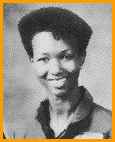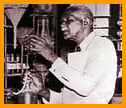Morgan was born in Paris, Kentucky, and was the son of former slaves (and the 7th of their 11 children). His formal education ended during elementary school.
As a a teenager (in 1895), Morgan moved north to Cincinnati, Ohio, looking for opportunity. His incredible ability to repair machinery led to many job offers from factories. In 1907, he started his own sewing equipment and repair shop. His business expanded in 1909; he employed 32 people, who used equipment that Morgan made (and invented) himself.
In 1920, Morgan went into the newspaper business, starting the "Cleveland Call." He was very successful, and eventually bought a car. While he was driving along the streets of Cleveland, he realized how unsafe intersections were, and was determined to make driving safer.
 Morgan patented a traffic signal on November 20, 1923 (U.S. patent No. 1,475,024, issued in 1923) - this was the first traffic signal patented, but not the first invented. His traffic signal was a T-shaped pole with arms (but with no lights) that has three signs, one or more of which popped out at a time: a red "stop," a green "go," and another red "stop in all directions." This last signal let pedestrians cross the street. It was controlled by an electric clock mechanism. This device became very popular, and was used all around the USA. Morgan sold his device to the General Electric Corporation for $40,000 (a huge sum at that time). His device was used until the three-light traffic light was developed.
Morgan patented a traffic signal on November 20, 1923 (U.S. patent No. 1,475,024, issued in 1923) - this was the first traffic signal patented, but not the first invented. His traffic signal was a T-shaped pole with arms (but with no lights) that has three signs, one or more of which popped out at a time: a red "stop," a green "go," and another red "stop in all directions." This last signal let pedestrians cross the street. It was controlled by an electric clock mechanism. This device became very popular, and was used all around the USA. Morgan sold his device to the General Electric Corporation for $40,000 (a huge sum at that time). His device was used until the three-light traffic light was developed.Morgan developed many other inventions, including a safety hood and smoke protector for firefighters (patent No. 1,113,675, in 1912), a gas mask (patent No. 1,090,936, in 1914). He also developed a zig-zag sewing machine attachment, a hair straightener, hair dying lotions, de-curling hair combs (patent No. 2,763,281, in 1956), and other inventions.
 Martin Luther King, Jr., was a great man who worked for racial equality and civil rights in the United States of America. He was born on January 15, 1929, in Atlanta, Georgia. Martin had a brother, Alfred, and a sister, Christine. Both his father and grandfather were ministers. His mother was a schoolteacher who taught him how to read before he went to school.
Martin Luther King, Jr., was a great man who worked for racial equality and civil rights in the United States of America. He was born on January 15, 1929, in Atlanta, Georgia. Martin had a brother, Alfred, and a sister, Christine. Both his father and grandfather were ministers. His mother was a schoolteacher who taught him how to read before he went to school.



